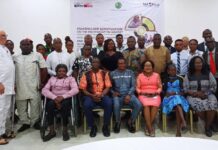 |
| Lady with Neuro Fibromatosis not Monkeypox (M) |
Frankie Ifop|10 November 2017
A team of Medical professionals from the Efik National Association (ENA) Inc, USA Free Medical Outreach in Calabar, Cross River State on Wednesday debunked the rumours of a patient who came for free medical treatment and tested positive for Monkey Pox virus. The doctor said, the information is false.
The Information was debunked by Dr. Udeme Asibong, Chief Consultant, Department of Family Medicine, University of Calabar Teaching Hospital (UCTH), Senior Lecturer, University of Calabar and also the Medical Director of The Calabar Hospital (TCH) (formerly known as The Calabar Women & Children Hospital) who was also volunteering for the ENA Free health outreach.
Dr. Asibong who examined the patient very well said the condition is Neurofibromatosis and not Monkey Pox as stipulated by media reports.
The Information was also confirmed by Mrs. Patience, Cross River State Epidemiologist, Ministry of Health. According to the her, Neurofibromatosis is a genetic disorder that runs in most family. Adding that the person actually came for Free medical treatment not based on the Monkey Pox condition.
Patience said she was sent by the Cross River State Commissioner for Health, Dr. Inyang Asibong to investigate the rumours. She urged all Cross Riverians not to panic, adding that they should go about and live their normal hygienic lives as well as take precautionary measures always
Neurofibromatosis (NF) according to Wikipedia is a group of three conditions in which tumours grow in the nervous system. The three types are; neurofibromatosis type 1 (NF1), neurofibromatosis type 2 (NF2), and schwannomatosis.
In NF1 symptoms include light brown spots on the skin, freckles in the armpit and groin, small bumps within nerves, and scoliosis. In NF2 there may be hearing loss, cataracts at a young age, balance problems, flesh colored skin flaps, and muscle wasting. The tumours are generally non cancerous.
The cause is a genetic mutation in certain genes. In half of cases these are inherited from a person’s parents while in the rest, they occur during early development. The tumours involve supporting cells in the nervous system rather than the neurons.
In NF1 the tumours are neurofibromas (tumours of the peripheral nerves), while in NF2 and schwannomatosis tumours of Schwann cells are more common.
Diagnosis is typically based on the signs and symptoms and occasionally supported by genetic testing.
There is no known prevention or cure. Surgery may be done to remove tumours that are causing problems or have become cancerous. Radiation and chemotherapy may also be used if cancer occurs. A cochlear implant or auditory brainstem implant may help some who have hearing loss.
Frankie Ifop
Writes from Calabar









